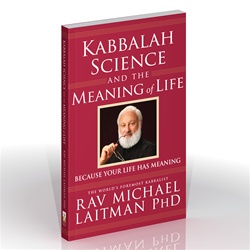Are You Aware of the Amount of Reality that Exists that You Don’t Perceive?
The wisdom of Kabbalah (“reception” in Hebrew), as its name implies, teaches us how to receive. It explains how we perceive our surrounding reality. To understand who we are, we must first learn how we come to sense reality around us, and how to cope with the events that befall us. The wisdom of Kabbalah provides us with all these insights.
The wisdom of Kabbalah does not come to an individual naturally, but only when one reaches the right level of ripeness. This is why Kabbalah is being exposed to so many these days, and this is also the reason why it was hidden for thousands of years.
Previous generations believed that the world exists by itself, whether or not we are there to perceive it, the world is the way it is and exists objectively, independently. Afterwards, people began to understand that our picture of the world is shaped by who we are. In other words, the picture of the world is a combination of our own attributes and external circumstances.
Therefore, we perceive only a part of everything around us. For example, right now there are numerous waves outside us, but we can only perceive one of them, the wave that we are attuned to perceive. Hence, we perceive external conditions according to our internal qualities. If we have nothing in common with the outside world, we will not perceive or feel any of it.
Kabbalah speaks extensively of our perception of time, space, and motion. Why does it seem to us that reality expands, that it is at a certain distance from us? What is the source of our perpetual sense of movement and change? Is this a result of internal processes that we are experiencing, or does it exist regardless of them?
The more we progress in the study of our internal being, the more we find that our perception of reality depends on us. Once humankind sufficiently evolves in knowledge, science, and technology, we will be able to perceive what the wisdom of Kabbalah has to offer.
Here Is a Method that Is Helping People to Perceive the Entirety of Reality
The wisdom of Kabbalah says that around us there is only “The Upper Light,” a single force in a permanent, unchanging state. Nothing exists besides this Upper Light. In such a state, the words existent or nonexistent mean the same because we only measure changes. When there are no changes, there is nothing to measure.
Within each of us is a “gene,” a bit of information that constantly evokes in us new sensations and emotions. We picture the world from within these sensations, which is where we derive the awareness that we exist. All these processes occur within us and design our perception of the outside world.
Actually, nothing exists outside of us, but our picture of reality appears as if it were outside of us. The concept I am presenting here was described by the greatest Kabbalists thousands of years ago, and is both fascinating and awesome in the richness of experiences it provides. It is written in The Book of Zohar (The Book of Radiance) that only when we understand that perception, experience it, and master it will we understand the writings in the Kabbalah books and in the Zohar itself.
Once we have recognized the limits of our perception, Kabbalah can teach us how to discover what really exists outside of us. Through Kabbalah, we can transcend our natural qualities, build new tools of sensation, and through them fully experience the external reality.
When we are liberated from the chains of our innate perceptions, we can discover a whole new world and begin to experience life’s eternal, complete, and unbounded flow. We will be able to experience the forces that operate on reality as a single power, and events that seemed accidental to us, unexpected or incomprehensible will suddenly make sense.
For such people, the spiritual world can become a system of forces that stands behind our perceived reality, the forces that propel reality. It is similar to examining embroidery: from the front, it looks like any other picture, but from the back, you can see the threads that comprise the picture, and their interconnections. Discovering these threads and interconnections provides knowledge about ourselves and the world around us.
Why Is Kabbalah, a Long Hidden Science, Now Being Revealed?
The wisdom of Kabbalah is appearing now because we are living in a special time: on the one hand, we have many ways to succeed at being happy, but on the other hand, we cannot seem to achieve it. Kabbalah does not repeal any other teachings or sciences. Nor does it challenge humanity’s progress over the generations. It cherishes humankind’s achievements, but as we come to the crest of these achievements, humanity is beginning to experience a growing need to sense the complete reality. This is the reason for the growing interest in Kabbalah today.
To reach this goal and to experience the spiritual world, we must cultivate within us identical qualities to those of the spiritual world. Everything we perceive in reality is through an equivalence of qualities. Therefore, we see and discover new things in the world according to the qualities within us.
As we mature, we acquire new qualities, both from our parents and from our surroundings. After absorbing them, we can use them to study our surrounding reality. We acquire many different kinds of attributes, some of which awaken in us naturally in time, and some that are acquired by the influence of our environment. However, some qualities cannot be acquired naturally, and must be developed within us through a special method.
The wisdom of Kabbalah builds such qualities. The act of studying authentic texts by genuine Kabbalists affect us as readers in a unique way, evoking subtle discernments. There are no other texts or methods in our world that can do so. The study of Kabbalah creates a special perception with which we can begin to see what appears to be “ordinary reality” from a new perspective.
We can compare it to looking at a stereogram (A picture in which the delineated objects have an appearance of solidity). When we look directly at the picture, it appears to be a medley of incomprehensible lines. But if we blur our gaze, we will be able to “penetrate” the picture and discover a rich, three-dimensional image.
The wisdom of Kabbalah acts on us in much the same way, helping us “capture” that picture. In fact, Kabbalah doesn’t present anything new, but simply refocuses our gaze so we can begin to “see.”
When a person begins to perceive the correct picture, and experiences the opening of the Upper World, this discovery is accompanied by the wondrous sensation of eternal life, and endless, boundless stream of pleasures. This is where our lives are leading us.
The Lazy Man’s Guide to the Extraordinary Achievements in Kabbalah
The wisdom of Kabbalah has evolved over thousands of years and been disseminated among Kabbalists throughout history. I would like to briefly review the key points in this process.
- The first Kabbalist was Abraham the Patriarch (approximately 1,800 BCE). Sefer Yetzira (The Book of Creation) is ascribed to him.
- 500 years after Abraham, Moses wrote his Book of Torah (The Pentateuch), around 1,350 BCE.
- In the 2nd century CE Rabbi Shimon Bar-Yochai wrote Sefer ha Zohar (The Book of Splendor).
- Kabbalah thrived in the 16th century Israeli town of Safed, led by the Kabbalist Rabbi Yitzhak Luria Ashkenazi, the Ari (1534-1572). He presented his method in his books, and today the wisdom of Kabbalah is founded on the Lurianic Kabbalah (the Kabbalah of the Ari). Lurianic Kabbalah relates to Kabbalah as a science—there is no meditation, chanting, charms, amulets or magical drawings of letters.
- Rabbi Yehuda Ashlag (1884-1954), known as Baal HaSulam (owner of the ladder) for his Sulam (Ladder) commentary on The Zohar, paved the way for our generation. His writings enable all of us to connect to the ancient, authentic sources that the past giants left behind.
The Kabbalah that we study today contains the same knowledge that was passed on from Abraham through all the generations.
 “You Don’t Have to be a Kabbalist to See Why Kabbalah Is So Needed Today” is based on the book, Kabbalah, Science and the Meaning of Life by Dr. Michael Laitman.
“You Don’t Have to be a Kabbalist to See Why Kabbalah Is So Needed Today” is based on the book, Kabbalah, Science and the Meaning of Life by Dr. Michael Laitman.

